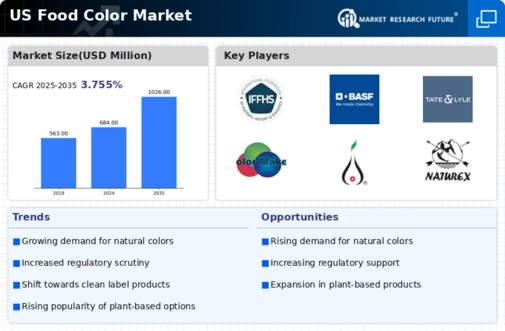Innovation in Food Product Development
Innovation plays a pivotal role in the natural food-color-ingredients market, as manufacturers continuously seek to develop new and exciting food products. The introduction of novel food items that utilize natural colorants not only attracts consumer interest but also enhances brand differentiation. Companies are increasingly experimenting with unique combinations of natural colorants to create visually striking products that stand out on shelves. This innovative approach is supported by advancements in food technology, which enable the effective extraction and application of natural colorants. As the market evolves, the emphasis on innovation is expected to drive the growth of the natural food-color-ingredients market, as brands strive to meet the demands of an ever-changing consumer landscape.
Rise of Health-Conscious Eating Trends
The natural food-color-ingredients market is significantly influenced by the rise of health-conscious eating trends among consumers. As individuals become more aware of the nutritional value of their food, there is a growing preference for products that not only look appealing but also contribute to overall health. This trend is reflected in the increasing sales of organic and natural food products, which have seen a growth rate of approximately 15% annually in the US. Consequently, food manufacturers are increasingly turning to natural colorants to enhance the visual appeal of their products while aligning with health-oriented consumer preferences. This alignment with health trends is likely to drive the demand for natural food-color-ingredients in the coming years.
Sustainability and Environmental Concerns
Sustainability has emerged as a critical driver in the natural food-color-ingredients market, as consumers and manufacturers alike become more environmentally conscious. The demand for sustainable sourcing of ingredients is on the rise, with many consumers willing to pay a premium for products that are produced with minimal environmental impact. This trend is prompting companies to adopt sustainable practices in their supply chains, including the use of eco-friendly extraction methods for natural colorants. Additionally, the emphasis on reducing carbon footprints and waste is likely to influence the sourcing and production of natural food-color-ingredients. As sustainability becomes a core value for consumers, the market is expected to witness a shift towards more environmentally responsible practices, further enhancing the appeal of natural food-color-ingredients.
Regulatory Support for Natural Ingredients
The natural food-color-ingredients market benefits from a favorable regulatory environment that encourages the use of natural colorants. Regulatory bodies in the US, such as the FDA, have established guidelines that promote the safety and efficacy of natural food additives. This regulatory support is crucial, as it provides manufacturers with the confidence to incorporate natural colorants into their products without facing significant legal hurdles. Furthermore, the increasing number of certifications for organic and natural products enhances consumer trust, thereby driving demand. As the regulatory landscape continues to evolve, it is anticipated that more companies will transition to using natural food-color-ingredients, further solidifying their position in the market.
Growing Consumer Demand for Natural Ingredients
The natural food-color-ingredients market experiences a notable surge in consumer demand for products that are perceived as healthier and more natural. This trend is driven by an increasing awareness of the adverse effects associated with synthetic additives. According to recent surveys, approximately 70% of consumers in the US express a preference for food products containing natural ingredients. This shift in consumer behavior compels manufacturers to reformulate their products, thereby expanding the market for natural food-color-ingredients. As a result, companies are investing in sourcing high-quality natural colorants derived from fruits, vegetables, and other plant sources. This growing consumer inclination towards transparency and health consciousness is likely to propel the natural food-color-ingredients market further, as brands strive to meet these evolving expectations.






















Leave a Comment